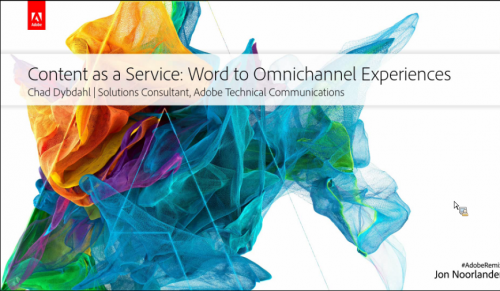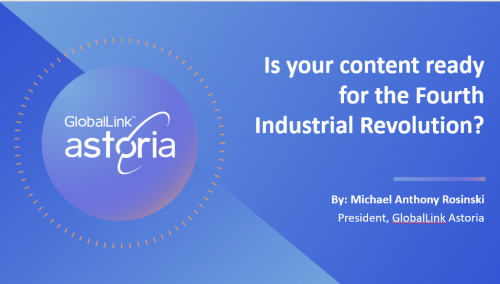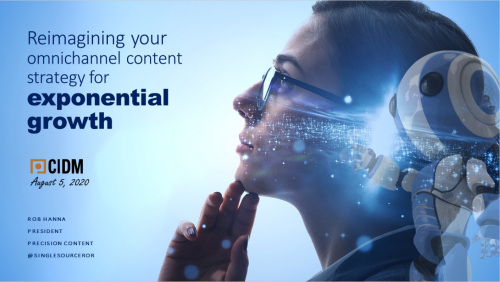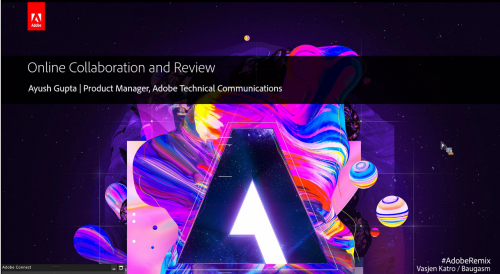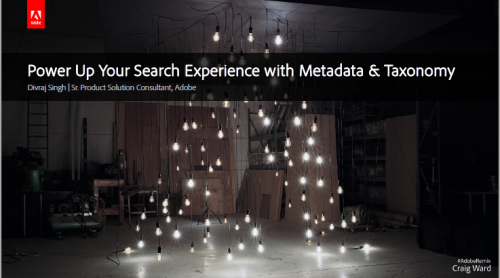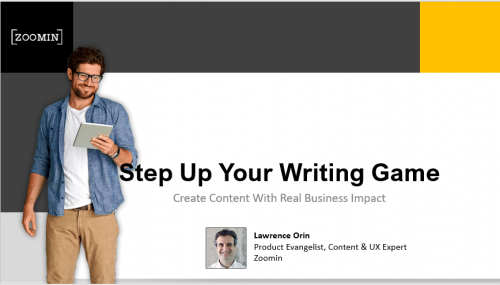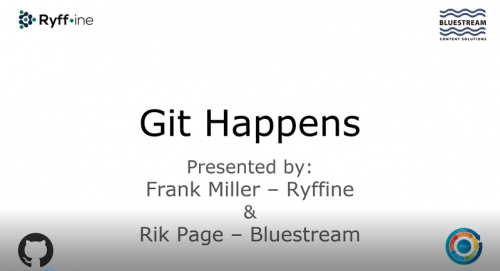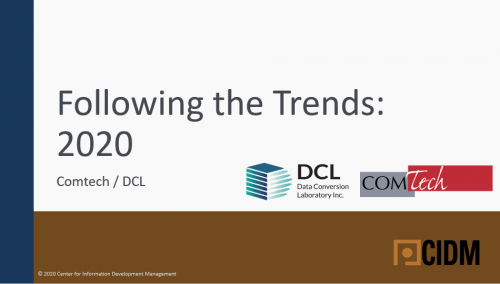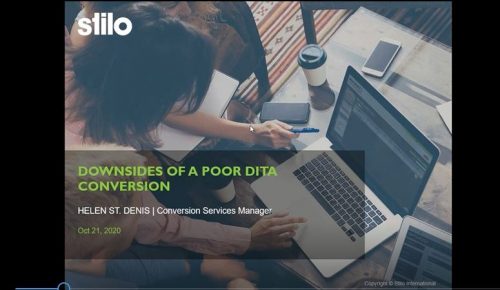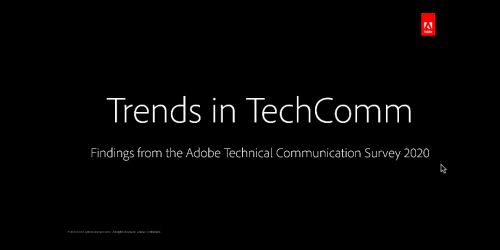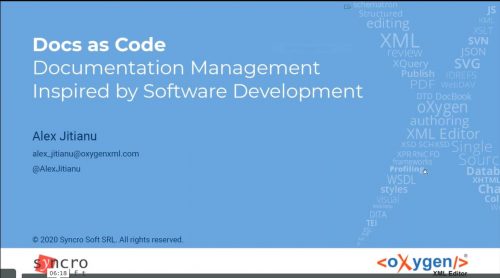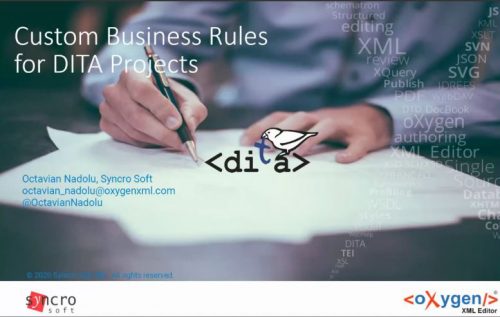- Strategies to repurpose your technical content in new ways
- Headless content delivery: what is it and why you need it
- Creating structure from (MS Word) chaos
-
Date: August 12, 2020 Squatches, yeti, and kraken: oh, my! Learn about cryptozoology, cryptids, and… oh yes: the future of content strategy and digital experiences. Chad Dybdahl, Adobe Solutions Consultant, walks you through importing content from Microsoft Word, creating intelligent, structured content that can then be used across a wide range of delivery channels and platforms. In this session, we’ll see both traditional and headless delivery strategies that will inspire you to think about content in new and exciting ways.
-
July 15, 2020 The Fourth Industrial Revolution, sometimes described as the perfect storm of new technologies combined with the asteroid of digital information, has forced companies to adopt new organizational structures to create and distribute content. This presentation will define the new exponential organizations, companies that grow often at 10 times faster than comparable companies, and are guided by a massive transformational purpose to deliver Information Enablement through innovations such as “Content as A Service” – CAAS. Presented by: Michael Rosinski has lead a successful career as a technology executive in the enterprise software industry. Presently, Michael is President of Astoria Software which is the premier CCMS – Component Content Management System in the Technical Product Documentation Vertical. At Astoria, he was first to market to launch the Enterprise SaaS Model and Mobility Platforms. Michael merged the Goldman Sachs venture to TransPerfect, the largest private translation company in the world. Prior to Astoria, Michael was a founding member of American Software’s management team, grew revenues to $ 100M+ and made it to the Forbes Best 200 Small Companies in America list. At American, Michael completed one of the first IPO’s in the ERP market, and later contributed to the successful spin off IPO of Logility in the Supply Chain Management Space. Michael leveraged his international experience as President of Augeo Software, a French/Dutch company in the PSA Professional Automation Space where Computerworld designated them as one of “The Top 100 Companies to Watch” Michael also held Management positions at Johnson & Johnson and Nestle.. Michael holds a Bachelors Degree in Management and Organizational Behavior at Rider University, and has completed MBA study at Fairleigh Dickinson University.
-
August 5, 2020 Abstract Business leaders around the globe are looking for ways to replicate the successes of innovative and disruptive organizations like Uber, Amazon, and Spotify that grow exponentially. Rather than adding 10%, they’re looking for 1000%. Exponential growth is deliberate and involves organizations developing capabilities that dramatically outperform the competition. Rob Hanna explores how information-enablement across the enterprise is key to this type of performance and why we need to rethink how we create content to become Exponential Organizations. What you’ll learn
- The definition of “information enablement”
- How your content is tied to your brand’s ability to grow exponentially
- How the 4th Industrial Revolution will impact global businesses, including yours
-
June 10, 2020 Abstract World has seen a very different modus operandi in the last couple of months. This only emphasizes the fact that collaborating without physically being in the same space is fast becoming the norm where team members are either located in different geographical locations or are working from home. At this time, a smooth review and collaboration process for technical content can be a real boon to your organization. In this session, Ayush Gupta, Product Manager at Adobe, will discuss how organizations can transform their mundane, time consuming and cyclic review process into a more meaningful, error-free and productive collaboration experience for Content Creators and Subject Matter Experts (SMEs). Key takeaways:
- Why rethink about current review processes
- What are the benefits of adopting online review process for DITA content
- What are the basic tenets and features of an online review process
- A walkthrough of a typical collaborative review workflow and how to make it an experience for business users
-
May 13, 2020 There is an explosion of content today. But what makes your content stand out is – relevance and searchability. To ensure that customers don’t have to spend hours searching through your content, metadata is key. And to know what metadata to add while authoring, a well-established taxonomy is key. To design a truly best-in-class content search experience metadata and taxonomy need to work in tandem. In this webinar we will showcase:
- How to leverage metadata to make your content searchable
- What is the difference between good and bad taxonomies
- A live example of taxonomy development using Adobe Experience Manager
-
June 3, 2020 In these difficult times, it’s absolutely critical to demonstrate your value to your organization. As a technical communicator, your mission is to make sure you’re getting the right information to the right people. Part of the solution is to find the right tools – but they will only take you so far. Good content is crucial. You must write content in a way that best suits your audience and best matches their search patterns, so they can organically surface the information they need. Join Lawrence Orin, Product Evangelist and Customer Implementation Expert at Zoomin, as he takes an intriguing look at content strategy, and reveals a down-to-earth, practical approach that will ensure your writing is making a visible impact on your company. In it this webinar, you’ll learn:
- Practical steps to improving your writing skills
- Best practices for structuring content
- How to tailor your writing to your audience
-
June 16, 2020 Unlike a decade ago, organizations face few barriers to entry if they want to develop structured content in a DITA-based ecosystem. The increasing adoption of Git as a content platform, and the maturing of DITA-focused products like oXygen have removed many of the cost barriers to implementing DITA in an elegant and scalable way. Whether a stop on a longer-term transition to a CCMS or the final destination, a mostly open-source DITA tool chain can be a valuable proving ground for a sophisticated content strategy. In this presentation, you’ll learn how process, information design, scalable repository design, and smart use of oXygen and Git can be more than a short-term solution. You will also learn where Git falls short and when you should be using a DITA CCMS. Presented by: Frank Miller president/ founder of Ryffine is an industry thought-leader whose career has focused on leading enterprise client engagements and building an information development community, Frank has been involved in dozens of successful DITA implementations. In addition to partnering with many leading names in the information development and content management spaces, Frank enjoys sharing his insights on trends and facilitating the adoption of best practices throughout the community. Presented by: Rik Page is EMEA Sales and Marketing Director at Bluestream Software and has been working with both component content and document management solutions since 200. During this time, he has worked with custom DTDs and Schemas, S1000D, iSpec2200 and since 2005 DITA. Rik's practical experience ranges from data capture/content creation through to dynamic multichannel delivery. This has been achieved in a wide range of industries including banking and finance, manufacturing, central government, and education. A keen advocate of technology and innovation Rik has taken part in multiple consultancy projects and helped formulate solutions all over the world.
-
May 12, 2020 In its eighth year of collecting data, the Center for Information-Development Management (CIDM) and Data Conversion Laboratory (DCL) asked managers, information architects, writers, training developers, and more how they are addressing the challenges of meeting customer information needs. During the webinar we walk through the results of the 2020 Trends Survey, a study we have been conducting since 2012. We trace the changes in how we think about developing and delivering content. Learn how others in the information-development community are planning to respond to new customer demands for innovative approaches to development and delivery. Presented by: Dawn Stevens, President, Comtech Services and Director of CIDM has 28 years of practical experience in virtually every role within a documentation and training department, including project management, instructional design, writing, editing, and multimedia programming. Dawn is the perfect advisor to identify and remove the challenges you face in producing usable, technical information and training content. With both engineering and technical communication degrees, Dawn combines her solid technical foundation with strong writing and design skills to lead our team of consultants and specialists in providing the expertise you need. Mark Gross, President, Data Conversion Laboratory, is a recognized authority on XML implementation and document conversion. Mark also serves as Project Executive, with overall responsibility for resource management and planning. Prior to joining DCL in 1981, Mark was with the consulting practice of Arthur Young & Co. Mark has a BS in Engineering from Columbia University and an MBA from New York University. He has also taught at the New York University Graduate School of Business, the New School, and Pace University. He is a frequent speaker on the topic of automated conversions to XML and SGML.
-
October 21, 2020 Thinking of automating your entire conversion process to DITA? Wanting to handle conversion work manually, in-house? Before you proceed, think about how the conversion could help you derive the benefits of DITA that you expect. A simplistic approach may allow you to publish something that looks just like what you have now. But a really good quality conversion will help you to leverage content reuse, personalization and multi-channel publishing, as well as making it easier to maintain and update your content. For example, will your conversion generate keys and keyrefs for variables? How about a relationship table, to prevent broken links? Will menu cascades be correctly marked up, for localization purposes? Presented by: Helen joined Stilo as a technical editor. She now works closely with Stilo Migrate customers, helping them to analyze their legacy content and configure appropriate mapping rules. She also provides Migrate customer training and support. Helen has helped Migrate customers to convert tens of thousands of pages of content to DITA and custom XML. Helen holds a Bachelor of Arts in English from St. Francis Xavier University in Antigonish, Nova Scotia, and has pursued graduate studies at Queen’s University in Kingston, Ontario.
-
April 8, 2020 Technical Communication is in constant change: Requirements and expectations from both authors and consumers of technical content have changed dramatically over the last decade. The rise in digital experience innovation creates new customer expectations and demands. And enterprises around the world are exploring new ways to create new Content Interaction Experiences for their customers. In this presentation, Stefan Gentz will give insights from the Adobe Technical Communication Worldwide Survey 2019/2020. TechComm professionals from 60 countries participated in the survey. He will discuss the driving factors for enterprises around the world when it comes to technical communication. Why do companies choose to work with structured content, and why do they go for a CCMS? How do they deliver their content today – and how will they provide content tomorrow? KEY TAKEAWAYS
- Understand the key factors that are driving companies to move to structured content
- Understand which technologies companies use to author and deliver content today
- Know which are the “hottest” content delivery channels in the future to provide technical content to customers
-
September 16, 2020 Tools and techniques used in software development can also be applied for documentation management:
- Storage and issue management using GitHub
- Automated quality checks and continuous publishing using Netlify
- Editing and collaboration support
- Release strategies
-
December 16, 2020 A step by step guide to getting started with Schematron and Schematron Quick Fixes. Schematron and Schematron QuickFix (SQF) languages can be used to improve efficiency and quality when editing DITA documents. You can define actions that will add complex structure in your documents, or make modifications in multiple places or actions that will convert a structure into another. These changes are made by keeping the document structure valid and conforming to your project specification and will help the content writer add content more easily and without making mistakes. Join us to see:
- How to create business rules with Schematron
- How Schematron rules are applied
- How to apply specific Schematron rules on all DITA files
- How to develop Schematron Quick Fixes to make it very easy to solve the reported problems

